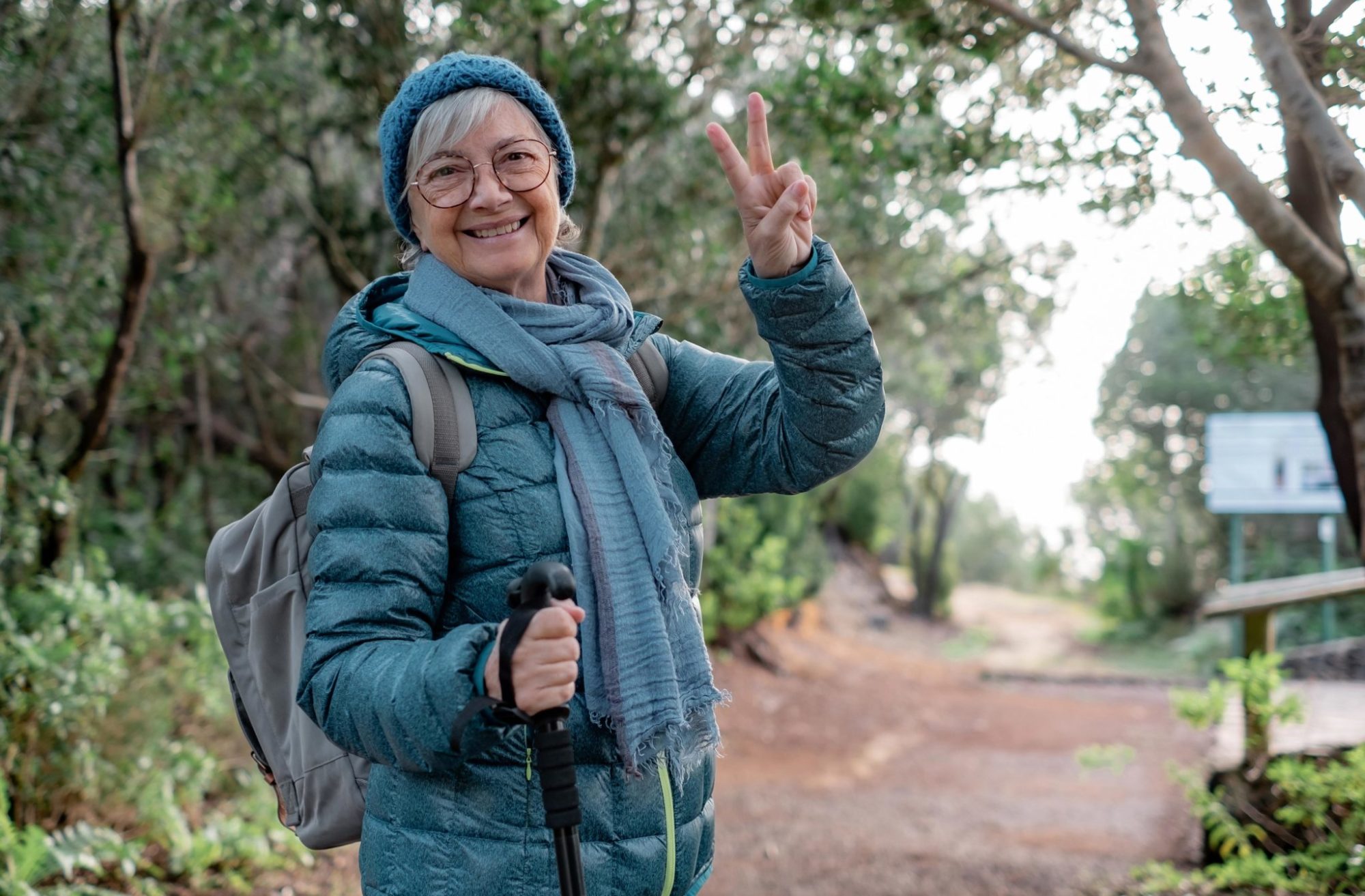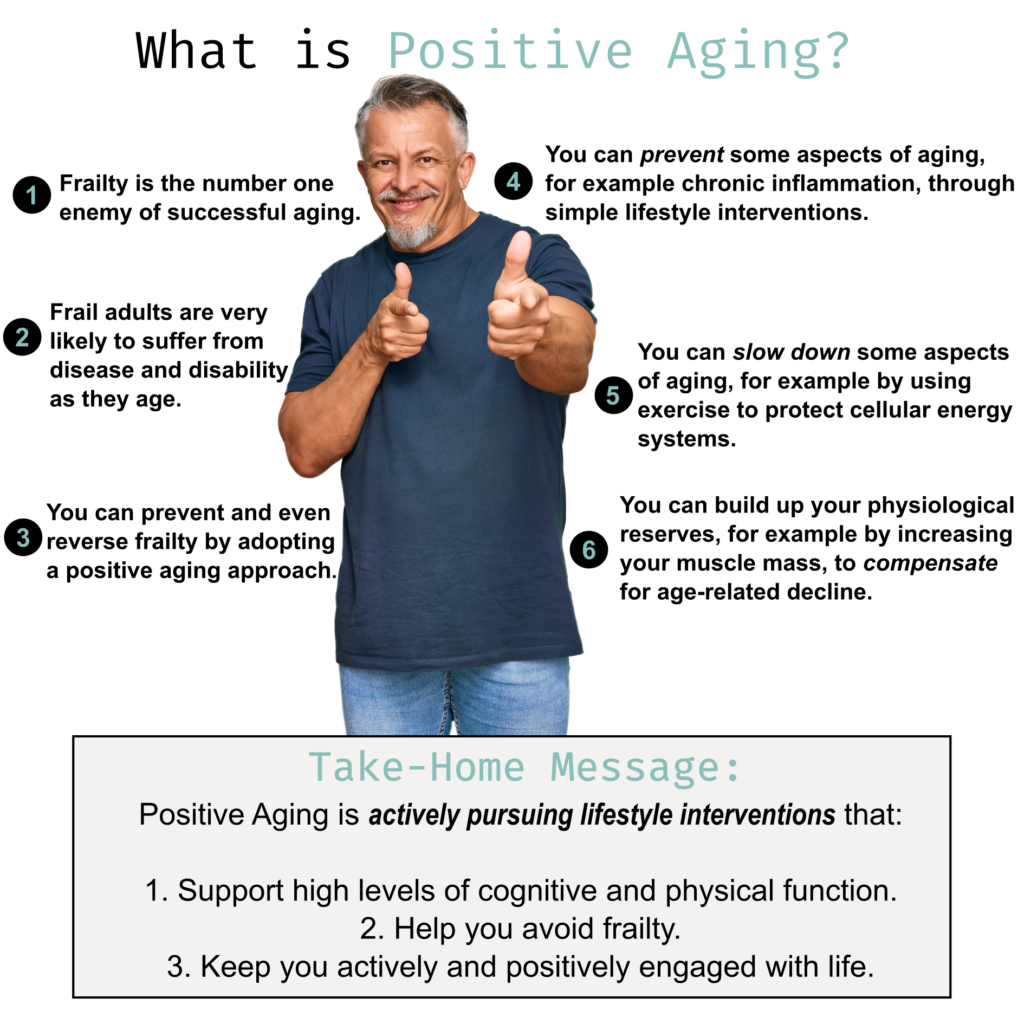What is Positive Aging?

“Youth is the gift of nature, but age is a work of art.”
Stanislaw Jerzy Lec
The Problem with Getting Old
Did you know that almost half of older adults are either disabled or on the way to becoming disabled?
Now, the crucial question is, will you allow age-related disability torpedo your golden years?
I certainly hope not!
Because I’m here to tell you that you can significantly reduce the risk disease and disability through Positive Aging.
What is Positive Aging?
OK, so what exactly is Positive Aging?
Well, I define Positive Aging as actively and systematically pursuing lifestyle interventions that:
1. Support high levels of cognitive and physical function.
2. Help you avoid disease and disability.
3. Keep you actively and positively engaged with life.
In other words, Positive Aging transforms you into someone who rarely gets sick, recovers quickly from illness and setbacks, and remains active, independent, and productive throughout your entire life.
Frailty: The Enemy of Successful Aging
However, if there is one thing that can really derail your retirement plans and long-term health, it’s frailty.
Indeed, I consider frailty (1) to be the number one enemy of successful aging (2).
What is frailty, you may ask?
Think of everything that sucks about getting old (3), such as cognitive decline, weakness, fatigue, poor mobility, depression, and social isolation.
That’s frailty.
Crucially, frail adults are very likely to suffer from disease and disability as they age.
For example, many people over 65 suffer from one or more chronic health conditions, such as high blood pressure, elevated cholesterol, arthritis, heart disease, and diabetes, amongst many others.
Worse, a significant proportion of older folk experience difficulties in daily activities such as walking, getting in and out of bed, essential self-care, and performing their regular day-to-day activities!
Thus, frailty culminates in long-term disease and disability that can last for a decade or more.
And being disabled is not how you want to experience your final precious decades of life!
Why do we age and become frail?
But why do we age and become frail in the first place?
The root of the problem lies in the complex systems within our cells, which degrade over time.
Indeed, the underlying cause of aging is the degradation of crucial subcellular systems, which damages or kills your cells, thereby compromising the function of your organs and physiological systems, ultimately compromising your overall health (4).
For example, as you age, your neuronal cells accumulate random genetic mutations and other cellular damage, impeding their function and reducing your brain’s ability to support cognition (5).
Over time, as more neurons are damaged or die, you may begin to experience noticeable cognitive impairment, a particularly dreadful hallmark of aging.
How does Positive Aging work?
While aging is inevitable, there are ways to slow down the process and prevent or reverse age-related disability through proven lifestyle interventions.
So, how does Positive Aging work, exactly?
Well, the rate at which you accumulate cellular damage is a function of random chance, your genetics, and your lifestyle (6).
Now, while you can’t do much about your genetics or the random nature of the universe, you can undoubtedly control your lifestyle.
And this is where Positive Aging comes into play.
Let’s take a closer look at the three ways Positive Aging can help prevent or reverse age-related disability.
1. Positive Aging Prevents Some Aspects of Aging
You can prevent some aspects of aging through simple lifestyle interventions.
For example, consider inflammation.
Healthy inflammation is an essential part of the immune response that plays a crucial role in clearing infection and healing wounds.
However, many older adults experience chronic inflammation (7), a state of low-grade, persistent inflammation that occurs even in the absence of an infection or injury.
Crucially, chronic inflammation is a hallmark of aging and can contribute to many age-related diseases.
For example, one common example of chronic inflammation is periodontitis, which is a chronic inflammatory disease that affects the gums and can lead to tooth loss and cancer (8).
Chronic inflammation is also associated with an increased risk of developing other serious conditions such as cardiovascular disease, type 2 diabetes, and certain cancers (4).
The good news is that you can significantly reduce chronic inflammation through diet and exercise (7).
Hooray!
2. Positive Aging Can Slow Down the Aging Process
Alas, some of the drivers of aging are impossible to avoid. But you can slow them down!
For example, an inevitable by-product of a aging is the degradation of your cells’ mitochondria, which has several unfortunate effects on the aging process (4).
Mitochondria are organelles within cells that are responsible for producing energy in the form of ATP. Because mitochondria are the powerhouse of your cells, loss of mitochondrial function means less energy for your cells to do their job.
Second, damaged mitochondria release free radicals, highly reactive molecules that can damage other cellular structures and contribute to chronic inflammation.
One common example of an age-related condition that is linked to mitochondrial dysfunction is age-related macular degeneration (14), a leading cause of blindness in older adults.
Fortunately, regular exercise improves your mitochondrial quality, density, and antioxidant capacity (15). Thus, one way that you can slow down aging is by maintaining your mitochondrial health through exercise.
3. Positive Aging Increases Your Physiological Reserves
Finally, there’s some aspects of aging that you can neither stop nor slow down. Fortunately, you can capitalize on biological plasticity to build up your physical reserves to protect yourself from the worst of the aging process.
What is biological plasticity? Well, biological plasticity refers to the ability of an organism or a system within an organism to adapt to changing environmental conditions (9).
One crucial example of biological plasticity is your skeletal muscle (10). You can activate the biological plasticity of your muscles by applying stress in the form of lifting heavy weights.
Resistance training forces your muscles to adapt by (i) growing bigger, (ii) increasing the number of fast-twitch muscle fibers within the muscle, and (iii) making muscular contractions more efficient through neuro-muscular adaptations (10).
Muscle plasticity means that if you train, you get stronger, even if you are old (11)!
Granted, once you are over fifty, you will never attain the absolute strength level that was possible during your twenties and thirties. However, resistance training will increase your strength far above that required for day-to-day living (11).
In effect, strength training increases your physiological reserve of muscular strength and power, protecting you from the impact of the age-dependent decline in muscle quality and quantity.
Another pertinent example of biological plasticity is the brain’s ability to reorganize itself in response to learning, injury, or disease.
This is known as neuroplasticity and helps explain how self-directed learning and engaging in social activities can prevent age-related cognitive decline (12, 13).
Take Home Message
Positive aging helps you avoid age-related disability by (i) preventing some aspects of the aging process, (ii) slowing down other aspects of the aging process, and finally (iii) increasing your physiological reserves to compensate for those unfortunate (yet inevitable) age-related declines in function.
By applying the principles of Positive Aging, you can avoid disease and disability and lead a long, healthy, and fulfilling life.
In conclusion, if you want to ensure a successful and positive aging journey, then Positive Aging is definitely the way to go.

References and Further Reading
1. J. E. Morley et al., Frailty consensus: a call to action. J Am Med Dir Assoc 14, 392-397 (2013).
2. J. W. Rowe, R. L. Kahn, Successful aging. The gerontologist 37, 433-440 (1997).
3. E. Jaul, J. Barron, Age-Related Diseases and Clinical and Public Health Implications for the 85 Years Old and Over Population. Front Public Health 5, 335 (2017).
4. C. López-Otín, M. A. Blasco, L. Partridge, M. Serrano, G. Kroemer, Hallmarks of aging: An expanding universe. Cell 186, 243-278 (2023).
5. M. P. Mattson, T. V. Arumugam, Hallmarks of Brain Aging: Adaptive and Pathological Modification by Metabolic States. Cell Metab 27, 1176-1199 (2018).
6. V. N. Gladyshev, Aging: progressive decline in fitness due to the rising deleteriome adjusted by genetic, environmental, and stochastic processes. Aging Cell 15, 594-602 (2016).
7. B. Dugan, J. Conway, N. A. Duggal, Inflammaging as a target for healthy ageing. Age Ageing 52, (2023).
8. A. Hoare, C. Soto, V. Rojas-Celis, D. Bravo, Chronic Inflammation as a Link between Periodontitis and Carcinogenesis. Mediators Inflamm 2019, 1029857 (2019).
9. H. M. Schneider, Characterization, costs, cues and future perspectives of phenotypic plasticity. Ann Bot 130, 131-148 (2022).
10. H. Hoppeler, O. Baum, G. Lurman, M. Mueller, Molecular mechanisms of muscle plasticity with exercise. Compr Physiol 1, 1383-1412 (2011).
11. R. Cannataro et al., Strength training in elderly: An useful tool against sarcopenia. Front Sports Act Living 4, 950949 (2022).
12. J. Mintzer et al., Lifestyle Choices and Brain Health. Front Med (Lausanne) 6, 204 (2019).
13. S. Song, Y. Stern, Y. Gu, Modifiable lifestyle factors and cognitive reserve: A systematic review of current evidence. Ageing Res Rev 74, 101551 (2022).
14. J. Fehér et al., Microbiota mitochondria disorders as hubs for early age-related macular degeneration. Geroscience 44, 2623-2653 (2022).
15. L. Lippi et al., Impact of exercise training on muscle mitochondria modifications in older adults: a systematic review of randomized controlled trials. Aging Clin Exp Res 34, 1495-1510 (2022).

Ten Minutes is All You Need
Research has shown that ten minutes of moderate-to-vigorous exercise performed each day is enough to significantly reduce your risk of early death.

Submaximal Training for Older Adults
A simple strength program designed for older adults to to increase bone density and improve strength, power and muscle mass.




